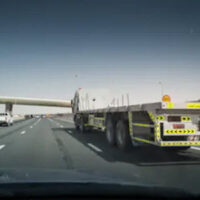Flatbed Truck Accidents in Florida

According to the Federal Motor Carrier Safety Administration (FMCSA), 107,000 large trucks were involved in injury crashes in 2017 alone, while an additional 363,000 contributed in some way to property damage only collisions. While some of these crashes involved semi-trucks, waste removal trucks, and tanker trucks, all of which pose a risk to motorists due to their large size and weight, many involved flatbed trucks, which are some of the most dangerous commercial trucks on the road. Flatbed truck accidents tend to result in particularly devastating injuries, so if you were recently involved in a crash with a flatbed truck or other commercial vehicle, it is critical to contact an experienced flatbed truck accident lawyer who can help you seek compensation for your losses.
Flatbed Trucks
As their name suggests, flatbed trucks are commercial vehicles with flat trailers and no sides or roof, which makes them uniquely equipped to transport odd shaped or oversized cargo, such as:
- Building materials for construction sites, including scaffolding, steel beams, bricks, lumber, and pre-fabricated items;
- Tire bales, which are composed of broken down and compressed rubber tires that are banded together with bailing wire;
- Debris from work sites, such as scrap metal;
- Heavy machinery, including military vehicles, farming equipment, heavy vehicle parts, and construction equipment;
- Super sacks, or industrial fabric bags, which are used to transport substantial amounts of dry products like fertilizer, grain, seeds, and sand; and
- Logs being transported to sawmills or paper mills.
Although transporting these types of unwieldy items is much easier and safer when loaded onto flatbed trucks, accidents involving these commercial vehicles still can and do occur, in which case, cargo could become loose and endanger others on the road.
Flatbed Truck Accident Causes
Most flatbed truck accidents can be linked to the specific load that a truck is transporting and a failure to properly secure it. Although trucking companies are instructed to use steel chains, nylon straps, tie-downs and wedges to secure cargo, the number and type of straps that must be used vary depending on the type of cargo and its weight. Failing to account for these rules can result in the load sliding off of the truck and into the road and path of oncoming vehicles. In some cases, improperly secured cargo can actually lead to an accident, especially if the load is not balanced correctly or violates height and weight requirements. Similarly, a fully loaded flatbed truck can obstruct the views of other drivers, making it difficult for them to see other vehicles or traffic signals.
Improperly securing cargo is not the only cause of flatbed accidents, which can also often be attributed to the inexperience of a truck’s driver who may be ill-prepared to respond to loose or shifting cargo or to account for inclement weather and poor road conditions. However, even when a truck driver’s negligence can be linked to a flatbed accident, the trucking company itself could also be held liable for a portion of the resulting damages if there is evidence that the company overloaded its trucks, failed to train employees on proper loading procedures, or did not regularly inspects its vehicles.
Call Today for Help with Your Case
Please call Boone & Davis at 954-566-9919 to schedule a free case evaluation with an experienced Fort Lauderdale flat-bed truck accident lawyer who can explain your legal options.
Resource:
fmcsa.dot.gov/safety/data-and-statistics/large-truck-and-bus-crash-facts-2017
https://www.booneanddavislaw.com/why-are-truck-accidents-so-dangerous-2/
